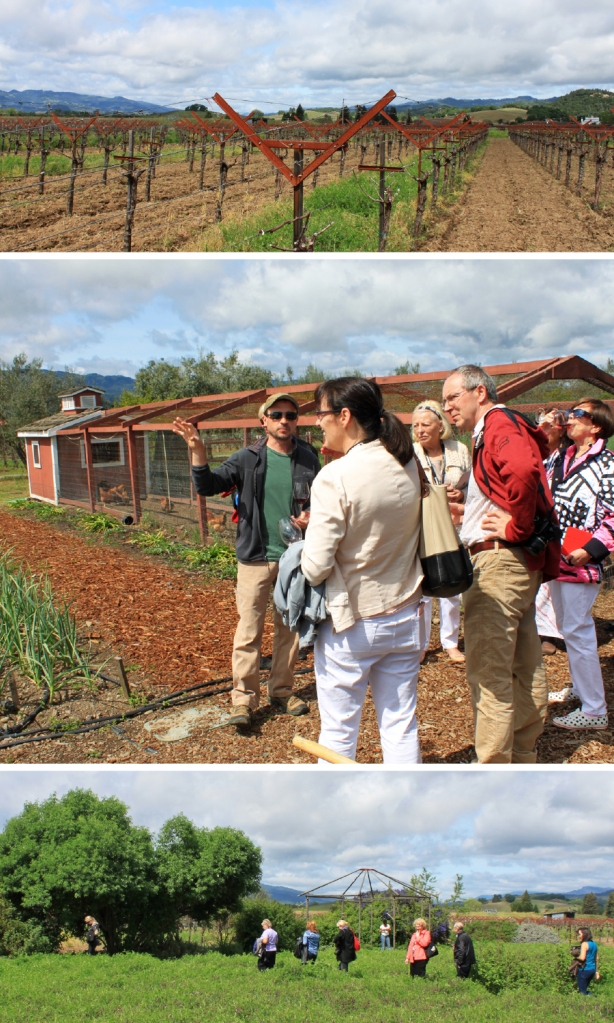Last Saturday we led a group of attendees from the International Association of Culinary Professionals (IACP) on a tour of Napa Valley’s most beautiful and interesting culinary gardens. The goal was to see the full range of possibilities for small scale farming in the valley and in visiting The French Laundry, Frog’s Leap and Oenotri at the Napa Chef Co-Op garden we saw a park-like garden that was as much public space as it was functional farm, a winery garden that reflected the property’s overall commitment to sustainability, and a garden that demonstrated the potential for committed chefs to reclaim unused space for cultivation. To round things out, we had perfect Napa Valley weather; setting out under misty, overcast skies but finishing the day in brilliant sunshine.
At The French Laundry’s Culinary Garden, Garden Manager Aaron Keefer paused his harvesting of edible blossoms for that day’s lunch service to show our group the many facets of Chef Thomas Keller’s operation. The French Laundry garden has grown through the years to cover nearly 2.5 acres and today includes a covered hoop house, composting and a chicken coop.
In addition to explaining the garden’s evolution while identifying some of the produce they are currently growing and gave us a peak of his newest addition: a snail farm where produce scraps are used to raise tasty escargot for future menus. He also brought the group into the hoop house where the season’s plant starters are grown and explained how tomato and pepper plants will be trellised up almost all the way to the structure’s ceiling. It was the perfect place to enjoy a typical Napa Valley morning transitioning from overcast to brilliant sunshine.

Top: Garden Manager Aaron Keefer offers a taste of lemon balm, Left: young celery, Right: the escargot farm
We continued on to the garden at Frog’s Leap Winery, where owner John Williams has been committed to sustainability since he founded the winery in 1981. Head Gardener Degge Hays was kind enough to join us and show the group around the property. Though his main focus is on the winery produce gardens, chickens, orchards and landscaping, he also answered questions about the vineyards, which are dry farmed meaning the vines subsist on the natural rainfall and available groundwater. As part of the garden program at Frog’s Leap the property makes its produce available to several local restaurants and the winery staff but they also produce their own barbeque and hot sauces, along with a variety of jams and preserves for their wine club (The Fellowship of the Frog). Just that week they had finished processing the end of last year’s chili crop into sauces.
The winery also poured a selection of their wonderful wines for our group, even coming out to serve them to us in the fields and gardens as we walked around. With a few extra minutes to spare, Degge gave the group a peak of the gorgeous barrel room in the main winery barn. Napa offers a wide variety of feasts for the senses, but one of the best is tasting wine surrounded by future vintages stacked in oak barrels.

Left: visiting the chicken coop, Right: Frog’s Leap’s home in renovated 1884 Adamson Winery, Bottom: inside the barrel room
Finally we returned to the city of Napa for a visit to the Napa Chefs Co-Operative Garden and lunch provided by two of the garden’s leaders: Tyler Rodde and Curtis Di Fede of Oenotri. The co-op garden began as a guerilla effort to reclaim some of the gardens abandoned when the Copia Food & Wine Center closed suddenly in 2008. The project has evolved to encompass additional acreage and now exists on its own secure parcel with the full permission of the property’s owners. From the very beginning Oenotri’s Chef/Owners Tyler and Curtis were a leading force in organizing the garden, adding the produce harvested there to the production of their own four-acre parcel elsewhere in the valley. Lunch consisted of a delicious pork patty sandwich – made using meat from the whole pig Oenotri receives every week – with a simple yet delicious “pizzaiolo” sauce and a salad of roasted vegetables from the garden where we sat along the Napa River. In homage to our wine country setting we also enjoyed some of the great wines from Oentori’s list including some of the Italian selections featured in their Goccino wine club.

Top: Chef/Owner Curtis Di Fede describes Oenotri’s unique food program, Bottom: Chef/Owner Tyler Rodde shares his family’s deep roots in agriculture and the evolution of the co-op garden
It was a quiet ride back to San Francisco, with many of our tour participants dozing contentedly on the bus (always a good sign). The entire tour was just what we hoped it would be: a look at the wonderful, diverse culinary gardens of the Napa Valley as well as an opportunity to hear from the remarkable people who tend and manage these amazing properties season after season.












